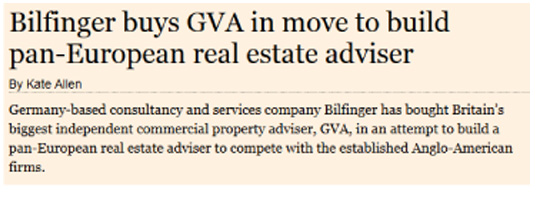5 inside secrets to successful mergers and acquisitions
16 May 2014 By Northern Lights

This week the German giant, Bilfinger, swallowed up GVA. Or rather – according to some media – GVA ‘agreed a merger with a global player’. Bilfinger is an €8.5bn company and the transaction is worth £150m. You decide, merger or acquisition?
Compare the two headlines below and you just know the hours of negotiation to agree the press release alone. And the real work hasn’t even begun (with thanks to Insider Media and the FT – click on the articles to go to the whole story).
In this blog I share with you years of experience in the M&A market – from being on the management merger team when Ernst & Young was formed to coaching a global ceo who merged a US/UK operation and years of PR, crisis communications and internal communications around the process – and even organising an FT conference on the subject. And I offer my own thoughts to ensure success.
What are the risks of mergers and acquisitions?
The problem with deals is that they are nearly always led by the financials – and dare I say it, a lot of egos. David Thurkettle of PwC last year analysed the state of law firms and said too many were trying to merge to improve profitability. But as he put it, if you have a pile of rubbish in one firm and merge it with another pile of rubbish, you just end up with a bigger heap (more about his research in this blog). And too often mergers are done to solve the wrong problems.
In my view, the key risks of mergers and acquisitions are
– Sensitivities and egos. The classic is pussy-footing around saying one company has taken over the other. If you can’t be honest pre-deal, you have created a Pandora’s Box to open post-deal
– Power games – everyone wants to be on the ‘winning’ side and will position themselves to be on the board, the head of their department, the key person for their expertise
– Skeletons in the cupboard. Poor due diligence is usually to blame – and often failing to take references and sound out clients and others about how they rate key people and directors. You are lucky if you find the skeletons in the first week or two. A shocker I heard was discovering that £1m work posted to WIP (work in progress) was actually fresh air – and not discovered for nearly a year
– The talk doesn’t match the walk. Both ceos and their PR teams create a vision that looks good in the press release but in the end proves difficult to deliver in reality. Look at the words used in two recent press releases
“…created one of the strongest firms focused on the mid-market, with the breadth and depth to work with ambitious businesses that want exceptional service and access to impressive UK and worldwide networks…” (BDO and PKF)
“This transaction offers us the opportunity to better serve customers by adapting more quickly to evolving shopping preferences in diverse regions across the country” (Albertson’s and Safeway)
– Leadership that doesn’t want to grasp the big issues. It is rare in a business that the troops don’t know what needs to be done as much as management. Management teams can quickly lose respect and employees become demotivated with the water cooler chat of ‘I knew it wouldn’t work’
– Drifting – not grasping the thorny issues quickly and making the big decisions that tell the troops you mean business – it is very easy with a complex deal to be a year on and little has changed and certainly the vision is not delivered
– Efficiencies. In the heady days of getting the deal done, many of the signatories may know that there will have to be cost-cutting and redundancies, but in the first raw days after the deal often avoid talking about this. Even if there are genuinely no plans initially, these can become needed later or you find good people and good teams start leaving.
I remember going round all my division on the day after the Ernst & Young merger was finalised and talking to each department to outline the vision and confirming no plans for redundancies. I genuinely believed what I was saying. Joe, who was nearing retirement, said in a kindly way ‘boss, sure you mean it but you tell me where are the partners left from….?” and rattled off a dozen names from the old Arthur McLelland Moores and other firms that had merged over the years to create our firm.
I was still relatively young and gut instinct at that moment told me Joe knew a great deal more than I did.
– Culture. When have you ever seen two businesses with exactly the same cultures? A speaker at the FT conference I organised years ago said that most mergers failed because of the people side – and a more recent paper by Deloitte on cultural issues in mergers and acquisitions cites 30% of mergers fail because of culture. Culture clashes are one of the biggest risks – which start with a failure to map the cultures of the two organisations and agree how the new combined business should operate: entrepreneurial and quick decision-making; listen to employees; fun; dictatorial; great service or whatever
So those are the nutty problems of mergers and acquisitions. How can you ensure success?
1. Focus on the customer
Keep everyone externally focused. Bring together teams from both sides to look at something like ‘how can our combined skills give better service to our customer, what should it look like?’
Getting employees to talk about your customers is one of the most energising and motivating things you can do for them. Given a steer, they will be creative and find solutions for you.
If you get the same people in a room and ask them to come up with a new departmental structure combining the two businesses, you will get politicking and posturing; fights to be King Bee and the process will result in anger and distraction. Little will be achieved to add value to the business.
Avi Dan, a Forbes blogger, says the $35bn proposed merger between Omnicom and Publicis fell apart this month because ‘there was nothing in it for clients’.
This is not easy. Putting the customer at the heart of every meeting, every discussion around job roles and every plan about who should be located where, will be one of the most difficult things you have ever done. Walk into every meeting, start every conversation about the customer and keep them metaphorically sitting on the table in your midst.
2. Focus all communications around the customer
Continuing the theme. Internal communications must be about the customer – joint understanding of the two customer bases; their issues; how what you are doing and changing will improve services and products for the customers.
The customer has to come through in newsletters, website communications, emails, notes of meetings.
In the press releases above (about the two mergers) they used phrases about how the deals were for their customers. But they feel like ‘just words’? The releases should have had insights into what customers are asking for that the individual firms could not deliver, specific examples of how the combined skills and resources would actually deliver – market gaps, breadth of services etc.
3. Bring the customer to life
Put your customers and clients at the heart of your internal communications. Here are some ideas – and they will all help to strengthen relationships as well
– Do video clips on phones whenever anyone is meeting a customer (you don’t need to hire corporate video producers). Ask them what they think of the merger, concerns, where they think there are opportunities for themselves, what they would like the firms to address through the process. These are your golden nuggets of insights – get everyone doing this and sharing the key points
– Use relevant clips at the start of leadership meetings. Let their concerns and opportunities drive the agenda – this is one of the ways to keep customer-focused
– Use clips on your intranet, some can go on external websites (taking care not to give fodder or ideas to competitors)
– Make internal newsletters and communications all about customer feedback and how you are using this to drive restructuring, how you organise locations, recruitment etc – keep it focused on the customer
4. Strategic communications plan
Making a merger work is 99% communications. So make sure you manage communications – of course (guess what?) starting with how you are going to deliver the promise to the customer.
External and internal communications should be working hand in glove with the merger strategic plan – they are to deliver the plan, not something separate
5. Pace
I remember our mantra with the Ernst & Young merger was to ‘hit the ground running’. Amusingly, if you type into Google ‘hit the ground running’ and ‘merger’ and you will see this is a favourite phrase – just two examples below.
This point is well made. Time is quickly lost with a merger. Question everything – if you ask for a report, make it by the end of the week, not the month. Don’t look at the sales in two months, but get it started now. Deal with the toughest decisions quickly. Pace, pace, pace. And your comms plan needs to help you deliver that pace.
There are hundreds of successful mergers and acquisitions – from Disney and Pixar and JP Morgan and Chase to the Big Four accountancy firms, created by hundreds of mergers. If you want your merger or acquisition to be a success, we’d love to help you keep that focus on the customer, integrate the businesses, keep the pace – and deliver the results you intended.








